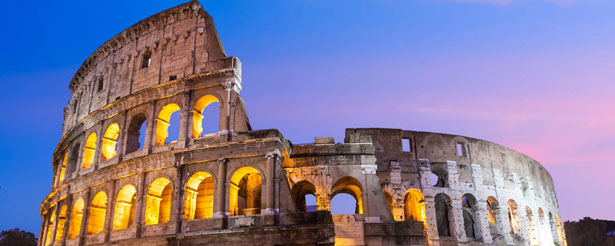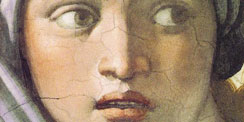The Roman Colosseum is undoubtedly
the symbol of the eternal city of Rome and even after two thousand years after its construction, it
rises prominently as one of the most extensive archaeological sites in the world. The real name of the Colosseum is the Flavian Amphitheater, after the Emperor Titus Flavius Vespasian who ordered its construction.
To visit the Colosseum, purchase an entrance ticket which entitles you to visit the inside of the Colosseum, the Roman Forum and the external archaeological area of the Palatine.
The Roman Colosseum is in a valley, surrounded by three of the seven hills of Rome: the Esquilino, the Esquiline Hill (which in archaic Latin means “forest of cork oaks”) and the Celio.
The Caelian Hill, whose name derives from the hero Celio Vibenna who helped Servio Tullio become the sixth king of Rome is one of the seven famous hills of Rome. The ancient name of the hill was Querquetulanus (oak forest), where gladiators (prisoners of war and slaves) lived in barracks (Luddi) which were divided according to their nationalities: germans, Celts, greeks and Africans. These barracks were connected with each other and with the Colosseum by a system of underground tunnels.
The Palatine The Palatine Hill perhaps the most famous hill (the word “palazzo” in European languages derives from the Palatine Hill: the “Palace of the Ceasars”). The Roman Emperors, from Augustus to Constantine, lived here for four hundred years, from 42 B.C. to 330 A.D.

The Roman Colosseum - a gorgeous monument
The Colosseum’s name comes from the “colossale” statue of Emperor Nero. The statue which is 35 meters high and made of glided bronze, was later transformed into the Helios sun god during the time of Hadrian (second century A.D.). During the sack of Rome in 410 A.D. by the Visigoths (former soldier mercenaries hired by the Roman army) led by Alaric, the statue was melted down and now only the pedestal remains. Visitors can enjoy this huge block of stone and realize the majesty of the destroyed statue while heading towards the main entrance of the Colosseum marked by oak trees and two cypress trees.
THE DIMENSIONS OF THE COLOSSEUM
The size of the Colosseum in its original plan boasted 52 meters high and 527 meters in perimeter. The amphitheater was well equipped with 76 entrances reserved for public access. On the arches to the right of the entrance you can still see the numbers above each entrance, in Roman numerals, for example LIII, LIV, LV. In addition, there were for four entrances for logistics and services. This immense structure could accommodate a total of 50,000 spectators: 45,000 seated and 5,000 standing in the top area, which corresponds to the fifth level, where there were usually the slaves and the common people. To protect the public from the sun and the rain there was a complex removable protective structure called the “Velarium,” composed of triangles of transparent fabric and waterproof canvas. The triangles were connected by metal rings and the removable structure was controlled by pulleys, hoists and ropes which were operated by 300 sailors. Outside the Colosseum, 100 meters to the left of the entrance, you can still see the five cleats that secured the anchor ropes that held up the giant mobile structure.
THE ROMAN COLOSSEUM STRUCTURE
The structure of the Colosseum is divided into five overlapping and concentric elliptical rings made of travertine, a material from the quarries of Tivoli. Each ring corresponds to a different class of Roman society. As previously mentioned, the common people and the slaves occupied the standing area of the fifth ring, the furthest away from the arena.
To ensure stability in this gigantic structure, special areas of reinforcement were designed both inside and outside the ring. Outside you can still see the holes where the huge bronze clamps welded with lead were inserted; these clamps were removed and fused during the Middle Ages for other purposes due to the shortage of metals. Inside the Colosseum bronze bars were used to hold the travertine blocks firmly together.
The amphitheater was decorated and embellished with numerous statues under each arch starting from the second level.
Before the construction of the Flavian Amphitheater the area was occupied by Nero’s golden House. This area extended for about 88 hectares and was occupied by palaces, gardens and even a lake: the Stagnum Neronis. Nero committed suicide in 68 A.D. when he was 31, and after there was a brutal civil war for the succession to the throne. Vespasian, an army general, killed the three pretenders to the throne, Otho, galba and Vitellius. Once in power he destroyed and partly buried the Domus Aurea and thus erased the memory of Nero’s presence (in Latin Damnatio Memoriae).
Lake Nero was drained and the foundations of the Colosseum were laid. The actual construction of the Colosseum began in 72 A.D. The amphitheater was inaugurated by the son of Vespasian, Titus, and was completed by Domitian in 86 A.D. The resources needed for the construction of this imposing architectural work, the money and slaves, all came from the spoils that the Romans secured with the destruction of Jerusalem and the Temple of the Jews in 70 A.D.
THE ROMAN COLOSSEUM SHOWS
The shows were organized during the summer for 18 hours a day and in the winter for 15 hours a day, two or three times a year in cycles of a week or more, but not every day, as the overall maintenance of the complex was very expensive and was practically entirely covered by the public. It is believed that the entrance ticket, which was in the form of a small clay tablet, cost very little and was sometimes even free.
In the mornings the fights took place with the wild beasts, lions, tigers, panthers, elephants, bulls, mastiffs dogs, bears, wild boars and gladiators. Weapons used included the trident, net, iron plated gloves and the Roman gladius sword which was about 70cm in length.
In the afternoons the audience watched the gladiators fight. The battles did not always end in the death of one of them because the gladiators were considered public figures very dear to the people and therefore they did not welcome death. The gladiators often organized bets amongst themselves and sometimes the public could attend public executions in the form of fighting or re-enactments of battles. The latter was a very impressive event as the arena was set up with scenery and animals that came up from the underground through a complex system of lifts, elevators and ramps. Between 80 and 86 A.D. the Roman authorities often staged naval battles in the Colosseum. There were gladiatorial battles on boats. In fact, they flooded the Colosseum for the occasion by using a complex hydraulic system which used the pre-existing channels of water from Lake Nero.
In 86 A.D. the Colosseum was completed by finalizing the underground and creating a wooden platform in the Arena which covered the sand used to absorb the blood from the fighting.
The shows were stopped in 523 A.D., especially those that involved hunting animals, and soon after the Colosseum was abandoned. During the Middle Ages it first became a burial ground, then the fortress of the Frangipane and then a rich quarry of materials (we believe that the steps of St. Peter’s Basilica were created using the large blocks of travertine from the Colosseum). The Colosseum was then considered a place where magical practices were carried out; it was believed to be cursed and that exorcism took place inside the walls. On the occasion of the Jubilee of 1675 the Flavian Amphitheater assumed the character of sacred place for the number of Christians martyred here, the tradition that requires a place of torture of Christians. It, however, was then suspended. In 1744 Pope Benedict XIV built the 15 shrines of the Cross and in 1749 the Colosseum was consecrated as a place of worship to Christ and the Christian martyrs. For the past two centuries, the Pope has celebrated the Way of the Cross inside the Coliseum on good Friday, during the Easter holidays.
Upon entering, on the right, after the ticket check point, you can see the Cross which indicates the consecration of the site. On both sides there remains pillars of the Loggia of the Emperors. The Loggia of the Emperors was the place where the public could see the Caesars and watch the shows.
Behind the Cross it is possible to go underground, where there are two levels reaching ten meters below ground level. This area housed the cages with the animals, the storage of gladiator’s weapons and the sets used during the performances. Here, even today, you can see the complex system of ramps, elevators, and trap doors that opened onto the wooden platform, to let in the animals and gladiators. To get a better idea of how these mechanisms worked, which were considered extremely ahead of their time, visitors can observe the reconstruction of the elevators located next to the modern elevator on the second floor.
The current wooden platform was rebuilt 14 years ago in about one-fifth of the total area. The marble seats for the public are completely gone, because some of this precious material was reused elsewhere for other building projects and the rest was destroyed by the earthquakes of the past centuries. Visitors can see a reconstruction of these marble seats in the area to the left of the cross.
The restoration work to save the Colosseum, due to damage caused by man’s negligence and the effects of time, was begun by Pope Pius VII in 1806. The first restoration projects were designed by architects Stern, Valadier, and Canina from 1811 to 1830. The results of this restoration work done in brick are still visible at the outer ends, including the fifth ring and the arches in brick, which are located at the exit of the monument, which corresponds to the third ring.
After 2,000 years we still do not know the name(s) of the person or people who designed and built the Colosseum, considered the seventh wonder of the ancient world, an impressive and extraordinary architectural work, still today the most innovative model of sport stadiums.
On the right upon leaving the Colosseum is the Arch of Constantine.









